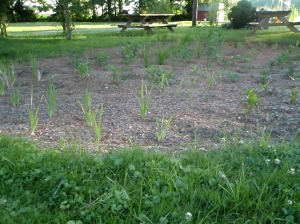 We plant flower gardens for beauty and vegetable gardens for food, though vegetable plants have a beauty of their own. In recent years, a new type of garden has been gaining prominence: a rain garden. While flowers can grace a rain garden with color, it is primarily designed to gather rainwater and allow it to soak into the ground instead of running off into sewers, storm drains, and streams.
We plant flower gardens for beauty and vegetable gardens for food, though vegetable plants have a beauty of their own. In recent years, a new type of garden has been gaining prominence: a rain garden. While flowers can grace a rain garden with color, it is primarily designed to gather rainwater and allow it to soak into the ground instead of running off into sewers, storm drains, and streams.
The benefits of a rain garden are many. An established rain garden attracts butterflies, bees, and other wildlife. Rain gardens can reduce erosion, flooding, and stream pollution and add water to the groundwater supply. Increasing numbers of homes, sidewalks, stores, roads, parking lots, and other paved places cover large areas of ground which cannot absorb rainfall but instead send rainwater runoff — and all the debris and pollutants it collects — directly into storm drains and streams. This results in stream pollution and a reduction in the groundwater level, which is crucial to many communities and individuals who rely on groundwater for their water supplies.
 Rain gardens can be constructed in any shape and size. The ideal site for a rain garden could be a low place in the yard where rainwater tends to puddle after a heavy storm. The location is further excavated to form a basin to collect runoff. Perennial native flowers, shrubs, and grasses with deep roots are planted to take up some of the water and to loosen the soil so that water can better penetrate the soil. Mulch is added around the plants to keep out weeds and absorb water.
Rain gardens can be constructed in any shape and size. The ideal site for a rain garden could be a low place in the yard where rainwater tends to puddle after a heavy storm. The location is further excavated to form a basin to collect runoff. Perennial native flowers, shrubs, and grasses with deep roots are planted to take up some of the water and to loosen the soil so that water can better penetrate the soil. Mulch is added around the plants to keep out weeds and absorb water.
The rain garden pictured here was planted on June 12 near the parking lot behind 140-year-old Jacksonville Presbyterian Church, a small, rural church in Burlington County, New Jersey. The church has long had a problem with water ponding at the side of the building, between the parking lot and the manse garage, and behind the manse garage. This year, the church’s Earthcare Ministry decided to investigate the possibility of installing a rain garden.
Church member Dave Specca, who works for the Rutgers Cooperative Extension, which is part of the New Jersey Agricultural Extension Service, arranged for a colleague, Mike Haberland, to give the church a presentation about rain gardens. Pastor Dana Eglinton and the church session approved the project. The church Youth Group and its leaders, Jim and Kathy Leedom, who will be participating in the Appalachian Service Project this summer, got involved. Jim Leedom designed the garden, and with the assistance of members of the congregation, the Youth Group dug and planted the rain garden on Sunday afternoon, June 12. Pinelands Nursery, a local business, provided the plants through the Natural Resources Conservation Service. The mulch was donated by two church members.
By the end of the summer, the plants will grow to fill in more of the garden. As the plants grow, the garden will become more efficient, but it is already helping with the church’s rainwater problem.
 Homeowners can create their own rain gardens. The best of information about creating a rain garden using native plants from your area is your local agricultural extension service or state university.
Homeowners can create their own rain gardens. The best of information about creating a rain garden using native plants from your area is your local agricultural extension service or state university.
For more information about rain gardens, you can also check these links: